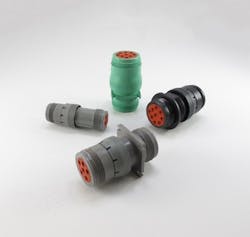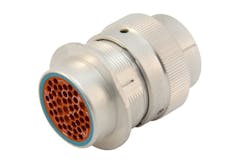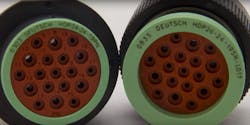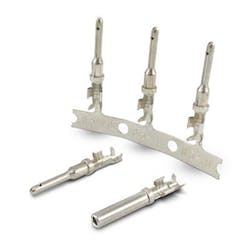Download this article in PDF format.
Harsh environments can be found in nearly every industry—aerospace, military, medical, agriculture, automotive, and so on. While each has unique characteristics of its own, they all share one thing in common: Volatile environments can wreak havoc with equipment and their connections.
Companies that manufacture equipment for use in these environments routinely ruggedize their designs, limiting the potential for failure. The same must be done for connectors, as vibration, temperature extremes/radiation, abrasive/corrosive chemicals, and fluids can render any equipment or power and data flows uselessly if the connection is compromised.
Sponsored Resources:
- HD30 Connectors for Harsh Environments
- HDP20 Connectors for Harsh Environments
- HD10 Connectors for Harsh Environments
1. Connectors developed by TE Connectivity. (Source: TE Connectivity)
Understanding the various conditions will help you determine the type of connector that’s required to maintain electrical continuity, thereby ensuring the uninterrupted flow of data and power.
In a perfect world, all ruggedized connectors would be universal, compact, hermetically sealed, easy to use, and inexpensive to manufacture. Unfortunately, no one design fits all. There are almost as many different types of connectors as there are harsh environments.
What Makes Them Rugged?
Ruggedized connectors have several features incorporated into their designs to protect against environmental challenges. Most notably, contacts, connector styles, seals, casings, and locking mechanisms. One of the most critical parts of any design is the contacts, as they’re designed to carry signals, making them a vital part of the connection. If that continuity of signal is lost or interrupted, applications and systems can fail.
To ensure connectors meet the varied requirements across different applications, manufacturers employ a wide range of materials depending on the environments they’re designed to work in.
Most ruggedized connectors are manufactured using high-grade corrosion-resistant metal or thermoplastic casings designed to resist environmental factors through years of exposure. Metal connectors, for instance, should be designed to handle the force and shock of hard or repeated impacts, while thermoplastic shells should be engineered for thermal and chemical resistance. Both should also feature secure locking-retention systems or mechanisms that enable connectors to retain a positive connection even under extreme conditions.
Metals
Connector casings can be manufactured using any number of metal alloy and thermoplastic materials depending on operational requirements. Popular choices among metal materials begin with aluminum, valued for its strength, lightweight, corrosion resistance, and low cost. Thus, it’s a top choice for most harsh-environment interconnect applications.
For example, TE Connectivity has a great example of utilizing aluminum with the Deutsch HD30 series housings, making them ideal for cable to cable applications with vehicles in tough environments such as mining, construction and forestry services. For more indepth information on TE Connectivity’s HD30 connectors, please visit the listing found here.
2. TE Connectivity Deutsch HD30 Series Harsh Environment Aluminum Housings are offered in multi-pin configurations and coupling rings for mating in cable-to-cable applications. (Source: TE Connectivity)
For added corrosion resistance, aluminum can be coated with a variety of surface finishes for added corrosion resistance, including cadmium (ideal for saltwater applications), zinc-nickel/zinc-cobalt (offers salt-corrosion resistance while being harder than cadmium), nickel/nickel-PTFE (increased corrosion resistance and tougher than cobalt), and anodizing. Anodizing, in particular, provides a non-conductive surface with minimal corrosion resistance.
In areas where corrosion resistance is paramount, manufacturers often turn to stainless steel, brass, and bronze for a connector’s outer casing, all of which are corrosion-resistant by design and have the added benefit of natural resistance to certain chemicals. In applications where weight is important, titanium is often used, indeed for high-temperature applications. However, it’s the most expensive material in the metal category.
Non-Metals
Composites and plastics are materials prized for their low weight, fluid resistance, and non-conductive properties. They can also be engineered to meet thermal-resistant thresholds and plated for increased ruggedness.
The HDP20 and HD10 composite thermoplastic housings from TE Connectivity are good examples of what can be done with these materials, which are specifically designed with chemical resistance in mind as they’re environmentally sealed and resist degradation in industrial applications. Those looking for more details about the HDP20 and HD10 series of connectors from TE Connectivity can find them here, and here, respectively.
The most widely used composite and plastic materials in this area include PEET (polyether ether ketone), PEI (polyethylene imine), and PPS (polyethylene sulfide). These are variations of glass-filled thermoplastics often used as substitutes for aluminum and can be found in optical and electrical applications. Due to their high thermal tolerances, they’re also popular in the oil and gas industries. Nylon is another widely used material due to its abrasion, chemical, and UV resistance.
3. Shown is TE Connectivity’s HD30 housing with 19 grommet cavities to house metal contacts. (Source: TE Connectivity via YouTube screenshot)
Protecting the Inside
Housings (shells) and casings aren’t the only aspects of harsh environment connectors that need to be ruggedized. It’s essential for the internal contacts to offer some form of protection as well. Contacts are typically formed/tooled using a pair of metals—one to form the shape and the other that acts as a plating. Both need to be corrosion-resistant as well as conductive for reliable signal and power transmission.
The most common metal used for standard applications is a copper base with a nickel plating. For low-voltage and data transmission, a gold plating over a copper core is preferable. Both offer excellent stability in sealed environments, offering efficient conductivity and durability.
The contacts are secured inside the housing with an internal grommet receptacle that can support a varied number of connectors. Most grommets are made from form-fitting, non-electrical conducting materials such as ceramic, rubber, or silicon and add another layer of protection against particles or fluids to ensure reliable operation.
To provide an extra-level of ruggedness for connectors in harsh environments, manufacturers will often use fluid-resistant seals to prevent ingress into the housing and connection points. These can come in many forms, including O-ring, wire, and interfacial seals. They form an air-tight, fluid-tight barrier to prevent corrosion and contamination. Most often these are made of silicone, as the material’s high level of flexibility, insulation, and sealing properties hold up in areas exposed to water and other fluids. They also resist cracking under variable temperatures.
4. Contacts housed inside the connector are secured using grommets made from non-conductive materials, offering another level of protection from particles and fluids. (Source: TE Connectivity)
Correct contact placement is key. The majority of rugged connectors employ secondary locks, otherwise known as wedgelocks or terminal position assurance locks. These lock types snap into the mating face of each connector and help the contacts slide together correctly when coupled.
These locks perform well in adverse environments and help provide a stable connection to both the housing and the connectors when mated, through the use of a lever-lock, push-latch, threaded coupler, or through tightening a jackscrew. A firm link will help protect against vibration and shock while providing a stable connection engagement in adverse conditions.
It’s All About the Ratings
Most every part of harsh environment connectors is regulated by a rating system and industry standards to ensure reliable operation in any given environment to which they’re rated. The Ingress Protection (IP) or International Protection Marking (IPM) system classifies/rates the level of protection against dust, fluid intrusion, and accidental contact. The system was designed using numerical codes of two digits to make detailed information easy to decipher. The first digit represents solid particle protection levels, while the second represents the level of protection against water.
For example, a standard harsh environment connector has a rating of IP67, which denotes it provides complete protection against dust and other foreign bodies and can prevent fluid ingress when immersed under defined pressures and timetables. By contrast, a Deutsch HD30 connector has an IP68 rating, which offers complete protection against dust and can be submerged in three feet of water continuously in an industrial setting.
Connectors intended for the harshest environments are designed with ease-of-use and on-site field service in mind. The capability to connect equipment and service connectors in their work environment is paramount and should be identical to tooling and processes done at the manufacturing level. This feature helps reduce training time and service time in the field, and promotes higher equipment uptime. It also reduces assembly time and the costs associated with new training programs.
Harsh or adverse environments present myriad challenges for connectors, and all aspects of their design can be affected based on the impacts of their given environment. Like every part of critical equipment, it just takes one component to fail or function improperly for the whole machine to break down. It’s easy to overlook something seemingly inconsequential as a simple connector over crucial hardware. But, how many times in industrial applications has that essential hardware stopped functioning over a fault as simple as a wire short, misaligned bolt, or even increased humidity?
It’s these small aspects that tend to be overlooked in the equipment chain and are often the ones that end up creating the most cost due to damage and downtime. Harsh-environment connectors were designed to keep equipment functioning no matter the application and to do so reliably.
The latest connector designs, for different industry applications, provide reduced electrical/data failures, minimized downtime, simplified assembly, increased production confidence, and fewer warranty claims. Without these ruggedized connectors, advances in the medical, automotive, oil/gas, marine, military, and aerospace industries wouldn’t be where they are today.
Sponsored Resources:
- HD30 Connectors for Harsh Environments
- HDP20 Connectors for Harsh Environments
- HD10 Connectors for Harsh Environments
Related Resources
TE Connectivity “DEUTSCH HDP20 & HD30 Connector Overview & Assembly Instructions”
TE Connectivity “Industrial & Commercial Transportation” Catalog—Terminals and Connectors, p. 147
TE Connectivity “Shipbuilding and Offshore Case Study Singapore”




